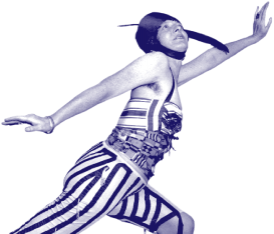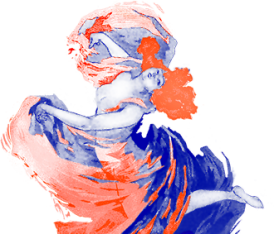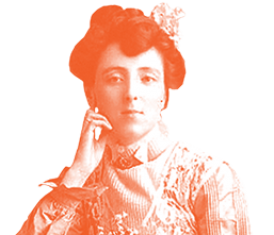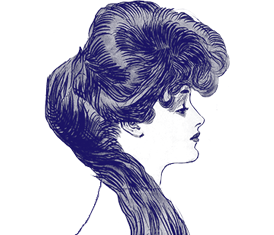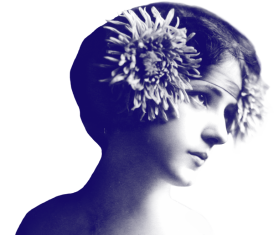Excerpts of Reviews [Translated from German]
This biography is an archeological masterpiece. Out of fragments gleaned from countless archives, ... Irene Gammel has reconstructed a passionate, narcissistic, and tragic life.
—Nico Neumann, Art
The story of the Dada Baroness as a walking performance piece is finally available in Germany in the first biography of this wild woman. We are indebted to Irene Gammel and to the women at Ebersbach press who have created a sparkling, brilliant book-art-work. Dada lives!
—Elisabeth Wehrmann, Die Zeit
“No Compromise to the public taste” was the motto of Elsa’s life and art. Her body and her radical energy were the core of her art, an art so new that her contemporaries had difficulties understanding her genius. Irene Gammel’s biography, the result of an giant scholarly research effort, is a labour of love and as riveting as a novel...
—Judith Luig, taz-Magazin.
Elsa was more than an eccentric woman—she was the most notorious dadaist in America. Her calculated use of shock was a weapon in her fight against the era’s false idealism and the madness of war. ... Elsa’s biography is as engrossing as her own performances....
—Jürgen Bräunlein, Neue Zürcher Zeitung
Photos of 1915 show the Baroness posing in her fantasy costume, wearing a tight cap with feather, a bustier, and skin tight pants. Until recently Elsa von Freytag-Loringhoven was considered a forgotten legend. Today the avant-garde poet is recognized as a revolutionary performance artist.
—Lisa Zeitz, Frankfurter Allgemeine Zeitung
Elsa was more radical than her Dada colleagues in Europe. Before Dada reached America, she had turned her body into a work of art. She stripped it, painted it, adorned it, and repackaged it, thus blithely anticipating Punk, Piercing and Body-painting. ... An excellently researched and elegantly written biography.
—Jürgen Bräunlein, Berliner Zeitung
The Baroness Elsa von Freytag-Loringhoven is one of the most interesting, yet almost forgotten artists of the last century. Irene Gammel has written her first biography. ... Elsa’s life will be an exciting story for a Hollywood motion picture.
—Melanie Kunze, Elle
The first biography of the “Mother of Dada.” Elsa used junk to create visual art. She used sex to create performance art. ... An erogenous reading zone.
—Hendrik Werner, Die Literarische Welt:
Elsa von Freytag-Loringhoven has earned her place in the annals of New York’s avantgarde.... [The biography is now available] in a luxury edition, a jewel in every book collection.
—Katharina Rutschky, Frankfurter Rundschau
Elsa was one of the first to invent ready-mades: freed from its original meaning the everyday object becomes an art object. The concept made Marcel Duchamp an icon of the international avantgarde. One of his most famous objects is a urinal which he declared a fountain. Irene Gammel discovered that the idea probably comes from the Baroness.
— Birgist Wolkse, Stilbruch, RBB-Television
Author Irene Gammel has worked more than ten years on researching the life story of Elsa von Freytag-Loringhoven. She has fulfilled the promise Djuna Barnes had once given (but not kept) to her friend Elsa—to write her biography. The result is a beautiful and compelling book about an extraordinary woman, who was far ahead of her time. The book is like a time-machine, through which readers are transported into an era more than 100 years ago, an era that seems remarkably contemporary. ... With this book the forgotten artist enjoys a glamorous come-back.
—Dagmar Trüpschuch, Lespress
The biography of Baroness Elsa does more than enlighten readers about the life of its heroine: the book explains what art was like in the beginning of the twentieth century.... This book is a must for all those interested in art.
—Perlentaucher.de
Sometimes it takes a long time for fame to catch up with the artist. And if the artist—think of Van Gogh, for instance—dies lonely and misunderstood, the biography can reach tragic heights. Such is also the case for the Baroness Elsa von Freytag-Loringhoven....
—Claudia Sandner-v. Dehn, Hessische Niedersächsische Allgemeine
|
Selected List of Reviews:
- Sephanie Tasch. Texte zur Kunst. 58 (June 2005): 196—200.
- Brigitte Siebrasse. Soziale Psychiatrie. 4 (October 2004): 57—58.
- Elisabeth Wehrmann, “Dazwischen ein Vogel. Die Großmutter des deutschen Dada ist zurück!” Die Zeit, Sonderbeilage Literatur, Oktober 2003.
- Judith Luig, “Völlig Dada.” Taz-Magazin. November 22-23, 2003.
- Nico Neumann, “Leidenschaftlich.” Art, January 2004.
- Jürgen Bräunlein, “Die Mutter von New York Dada: Baroness Elsa von Freytag-Loringhoven.” Neue Zürcher Zeitung. November 8-9, 2003.
- Katja Schneider, “Ein weibliches Genie.” tanz-journal, June 2003.
- Jürgen Bräunlein, “Nackt im roten Regenmantel: Baronin Elsa von Freytag-Loringhoven war die Dada-Ikone Amerikas.”Berliner Zeitung. 57. March 8-9, 2003.
- Dagmar Trüpschuch, “Die Dada Baroness.” Lespress. October 2003.
- Lisa Zeitz, “Die Zukunft, höchstpersönlich.” Frankfurter Allgemeine Zeitung, May 25, 2002.
- Redaktion. “Männerkrank zum Ohrläppchen: Dada-Queen von New York.” Schwäbisches Tagblatt. December 17, 2003.
- MH/CS. “Alles Live: Exzentrik und Exzess in neuen Romanen und Lebensgeschichten.” Vogue. October 2003, p. 214.
- Marion Klötzer, “Die hemmungslose Dada-Baroness: Körperkünstlerin der 20er Jahre.” Badische Zeitung. December 9, 2003.
- “Streetfighterin Elsa.” Perlentaucher.de. December 12, 2003.
- Katharina Rutschky, “Unbeinträchtigt von geistiger Gesundheit.” Frankfurter Rundschau, December 30, 2003.
- Melanie Kunze. “Ein Dada Märchen. Elle. August 2003, pp. 22-28.
|
Radio and Television Interviews and Reviews:
- Interview, Deutschlandradio, December 1, 2003, 15:30.
- Interview, Kulturradio, “Galerie,” December 1, 2003, 15:00-15:30 (live)
- Interview, RBB-Television, “Stilbruch,” December 11, 2003, 22:15.
- Interview, Radio Eins RBB,“Büchermagazin Seite Eins,” December 7,2003.
- Jürgen Bräunlein, “Die Mutter von New York Dada.” Deutschlandradio, “Merkmal.” December 12, 2002.
|
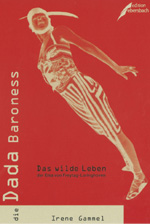
 Publisher Listing
Publisher Listing Image Gallery
Image Gallery



